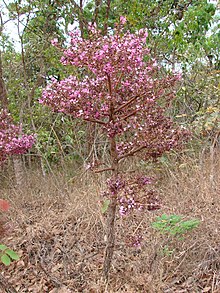
Summary
Andira is a genus of flowering plants in the legume family, Fabaceae. It is distributed in the tropical Americas, except for A. inermis, which also occurs in Africa.[3] It was formerly assigned to the tribe Dalbergieae, but molecular phylogenetic studies in 2012 and 2013 placed it in a unique clade within subfamily Faboideae named the Andira clade.[4][5]
| Andira | |
|---|---|

| |
| Andira humilis | |
| Scientific classification | |
| Kingdom: | Plantae |
| Clade: | Tracheophytes |
| Clade: | Angiosperms |
| Clade: | Eudicots |
| Clade: | Rosids |
| Order: | Fabales |
| Family: | Fabaceae |
| Subfamily: | Faboideae |
| Clade: | Meso-Papilionoideae |
| Clade: | Andira clade |
| Genus: | Andira Lam., nom. cons.[1] |
| Species | |
|
See text. | |
| Synonyms[2] | |
| |
Compared to other Faboideae the genus has unusual systems of root nodules[3] and fruits, which are drupes. In most species the fruits are dispersed by bats, and in some they are dispersed by rodents. They may also be dispersed on water.[6]
Plants of the genus are used in traditional medicine in Brazil to treat fever and as purgatives and vermifuges. The treatments are toxic in high doses, however. Chemical compounds isolated from the genus include isoflavones, flavanols, glycosides, pterocarpans, chromone, and ursolic acid.[7]
Species edit
As of April 2023[update], Plants of the World Online accepted the following species:[2]
- Andira anthelmia (Vell.) J.F.Macbr.
- Andira carvalhoi R.T.Penn. & H.C.Lima
- Andira chigorodensis R.T.Penn.
- Andira cordata Arroyo ex R.T.Penn. & H.C.Lima
- Andira coriacea Pulle
- Andira cubensis Benth.
- Andira cujabensis Benth.
- Andira fraxinifolia Benth.
- Andira galeottiana Standl.
- Andira grandistipula Amshoff
- Andira humilis Mart. ex Benth.
- Andira inermis (W.Wright) Kunth ex DC.
- Andira jaliscensis R.T.Penn.
- Andira legalis (Vell.) Toledo
- Andira macrocarpa R.T.Penn.
- Andira macrothyrsa Ducke
- Andira marauensis Mattos
- Andira micrantha Ducke
- Andira multistipula Ducke
- Andira nitida Mart. ex Benth.
- Andira ormosioides Benth.
- Andira parviflora Ducke
- Andira praecox Arroyo ex R.T.Penn.
- Andira spectabilis Saldanha
- Andira surinamensis (Bondt) Splitg. ex Pulle
- Andira taurotesticulata R.T.Penn.
- Andira tervequinata R.T.Penn., Aymard & Cuello
- Andira trifoliolata Ducke
- Andira unifoliolata Ducke
- Andira vermifuga (Mart.) Benth.
-
Andira fraxinifolia
-
Andira vermifuga
References edit
- ^ Pennington RT. (2002). "(1533) Proposal to change the authorship of Andira, nom. cons. (Leguminosae: Papilionoideae) and to conserve it with a conserved type". Taxon. 51 (2): 385–386. doi:10.2307/1554939. JSTOR 1554939.
- ^ a b "Andira Lam". Plants of the World Online. Royal Botanic Gardens, Kew. Retrieved 2023-04-23.
- ^ a b Pennington RT. (2003). "A monograph of Andira (Leguminosae: Papilionoideae)". Syst Bot Monogr. 64: 1–145. doi:10.2307/25027903. JSTOR 25027903. Archived from the original on 2014-02-22. Retrieved 2014-02-14.
- ^ Cardoso D, Pennington RT, de Queiroz LP, Boatwright JS, Van Wykd B-E, Wojciechowski MF, Lavin M (2013). "Reconstructing the deep-branching relationships of the papilionoid legumes" (PDF). S Afr J Bot. 89: 58–75. doi:10.1016/j.sajb.2013.05.001.
- ^ Cardoso D, de Queiroz LP, Pennington RT, de Lima HC, Fonty É, Wojciechowski MF, Lavin M (2012). "Revisiting the phylogeny of papilionoid legumes: new insights from comprehensively sampled early-branching lineages". Am J Bot. 99 (12): 1991–2013. doi:10.3732/ajb.1200380. PMID 23221500.
- ^ Pennington RT, Gemeinholzer B (2000). "Cryptic clades, fruit wall morphology and biology of Andira (Leguminosae: Papilionoideae)". Bot J Linn Soc. 134 (1–2): 267–86. doi:10.1111/j.1095-8339.2000.tb02354.x.
- ^ da Silva VC, de Carvalho MG, da Cunha e Silva SL (2007). "Chemical constituents from roots of Andira anthelmia (Leguminosae)". Rev Latinoamer Quím. 35 (1–2): 13–19. Archived from the original on 2010-05-23.


